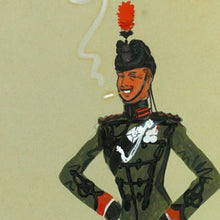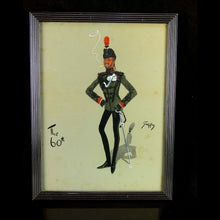The 60th A Snaffles Original, 1930
- Regular price
- £1,600
- Sale price
- £1,600
- Regular price
-
- Unit price
- /per
Adding product to your cart
Overall: 38.3cm (15in) x 29cm (11.4in)
Pencil and body colour on paper. Original caricature of an officer of the King’s Royal Rifle Corps in full dress comprising scarlet ostrich and black vulture feather plumed Astrakhan busby introduced in 1890, rifle green tunic with five rows of black frogging, cross belt with Maltese cross badge whistle and chains. Titled in the artist’s hand mid left. Signed ‘Snaffles’ centre right. Image: 34cm x 26cm. Framed and glazed.
Read more
Charlie Johnson Payne (1884-1967), ‘Snaffles’, was the son of a Warwickshire boot maker turned publican. As a boy ‘Snaffles’ was an avid consumer of Kipling and was fascinated by the yarns of a great uncle who had served in the Crimea. After working as a wine merchant’s clerk and serving in a volunteer battalion of the Oxfordshire Light Infantry, he enlisted in the Royal Garrison Artillery. After lights-out he read Kipling to his mates by candlelight in the barrack room. In the following years he developed his characteristic artistic style and a deepening interest in hunting, racing and polo. He became a regular contributor to periodicals, such as Bystander and the Sporting and Dramatic. Days spent in the hunting field with the Cottesmore provided ample inspiration for his much loved sporting scenes. Following the outbreak of War in 1914, he went to France as an illustrator for The Graphic before entering the Royal Naval Air Service as a rating Motor Mechanic in small coastal motorboats. Later he was commissioned Lieutenant RNVR, and joined the team that developed dazzle camouflage with the Northern Patrol. In 1920 he was made a Chevalier of the Belgian Order of the Crown. His artistic career continued between the wars producing works that often combined military scenes and nostalgic sporting themes. His work covering the equestrian life in England, Ireland and in the military in India was made extremely popular through the publication of prints that were initially hand coloured and later photographically printed over a fifty year period. Apart from the sale of his sporting prints, he contributed to many magazines and publications. During the Second World War he served in the Home Guard.






